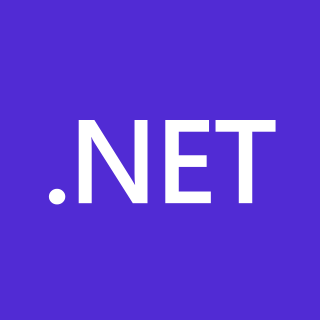Related Research Articles
The Common Language Infrastructure (CLI) is an open specification and technical standard originally developed by Microsoft and standardized by ISO/IEC and Ecma International that describes executable code and a runtime environment that allows multiple high-level languages to be used on different computer platforms without being rewritten for specific architectures. This implies it is platform agnostic. The .NET Framework, .NET and Mono are implementations of the CLI. The metadata format is also used to specify the API definitions exposed by the Windows Runtime.
The Common Language Runtime (CLR), the virtual machine component of Microsoft .NET Framework, manages the execution of .NET programs. Just-in-time compilation converts the managed code into machine instructions which are then executed on the CPU of the computer. The CLR provides additional services including memory management, type safety, exception handling, garbage collection, security and thread management. All programs written for the .NET Framework, regardless of programming language, are executed in the CLR. All versions of the .NET Framework include CLR. The CLR team was started June 13, 1998.
Common Intermediate Language (CIL), formerly called Microsoft Intermediate Language (MSIL) or Intermediate Language (IL), is the intermediate language binary instruction set defined within the Common Language Infrastructure (CLI) specification. CIL instructions are executed by a CLI-compatible runtime environment such as the Common Language Runtime. Languages which target the CLI compile to CIL. CIL is object-oriented, stack-based bytecode. Runtimes typically just-in-time compile CIL instructions into native code.
Microsoft Visual C++ (MSVC) is a compiler for the C, C++ and C++/CX programming languages by Microsoft. MSVC is proprietary software; it was originally a standalone product but later became a part of Visual Studio and made available in both trialware and freeware forms. It features tools for developing and debugging C++ code, especially code written for the Windows API, DirectX and .NET.
DotGNU is a decommissioned part of the GNU Project that started in January 2001. DotGNU aims to provide a free software replacement for Microsoft's .NET Framework by Free Software Foundation. Other goals of the project are better support for non-Windows platforms and support for more processors.
JScript is Microsoft's legacy dialect of the ECMAScript standard that is used in Microsoft's Internet Explorer 11 and older.
IronPython is an implementation of the Python programming language targeting the .NET Framework and Mono. Jim Hugunin created the project and actively contributed to it up until Version 1.0 which was released on September 5, 2006. IronPython 2.0 was released on December 10, 2008. After version 1.0 it was maintained by a small team at Microsoft until the 2.7 Beta 1 release. Microsoft abandoned IronPython in late 2010, after which Hugunin left to work at Google. The project is currently maintained by a group of volunteers at GitHub. It is free and open-source software, and can be implemented with Python Tools for Visual Studio, which is a free and open-source extension for Microsoft's Visual Studio IDE.

C# is a general-purpose, high-level multi-paradigm programming language. C# encompasses static typing, strong typing, lexically scoped, imperative, declarative, functional, generic, object-oriented (class-based), and component-oriented programming disciplines.
In Microsoft's .NET Framework, the Common Type System (CTS) is a standard that specifies how type definitions and specific values of types are represented in computer memory. It is intended to allow programs written in different programming languages to easily share information. As used in programming languages, a type can be described as a definition of a set of values, and the allowable operations on those values.
Comparison of the Java and .NET platforms.
The Dynamic Language Runtime (DLR) from Microsoft runs on top of the Common Language Runtime (CLR) and provides computer language services for dynamic languages. These services include:

MonoDevelop is an open-source integrated development environment for Linux, macOS, and Windows. Its primary focus is development of projects that use Mono and .NET Framework. MonoDevelop integrates features similar to those of NetBeans and Microsoft Visual Studio, such as automatic code completion, source control, a graphical user interface (GUI) and Web designer. MonoDevelop integrates a Gtk# GUI designer called Stetic. It supports Boo, C, C++, C#, CIL, D, F#, Java, Oxygene, Vala, JavaScript, TypeScript and Visual Basic.NET.

The .NET Framework is a proprietary software framework developed by Microsoft that runs primarily on Microsoft Windows. It was the predominant implementation of the Common Language Infrastructure (CLI) until being superseded by the cross-platform .NET project. It includes a large class library called Framework Class Library (FCL) and provides language interoperability across several programming languages. Programs written for .NET Framework execute in a software environment named the Common Language Runtime (CLR). The CLR is an application virtual machine that provides services such as security, memory management, and exception handling. As such, computer code written using .NET Framework is called "managed code". FCL and CLR together constitute the .NET Framework.
.NET Compiler Platform, also known by its codename Roslyn, is a set of open-source compilers and code analysis APIs for C# and Visual Basic (VB.NET) languages from Microsoft.

Mono is a free and open-source .NET Framework-compatible software framework. Originally by Ximian, it was later acquired by Novell, and is now being led by Xamarin, a subsidiary of Microsoft and the .NET Foundation. Mono can be run on many software systems.

.NET is a free and open-source, managed computer software framework for Windows, Linux, and macOS operating systems. It is a cross-platform successor to .NET Framework. The project is primarily developed by Microsoft employees by way of the .NET Foundation, and released under the MIT License.
ILNumerics is a mathematical class library for Common Language Infrastructure (CLI) developers and a domain specific language (DSL) for the implementation of numerical algorithms on the .NET platform. While algebra systems with graphical user interfaces focus on prototyping of algorithms, implementation of such algorithms into distribution-ready applications is done using development environments and general purpose programming languages (GPL). ILNumerics is an extension to Visual Studio and aims at supporting the creation of technical applications based on .NET.
References
- ↑ Sims, David; O'Reilly, Timonthy ‘Tim’; Dornfest, Rael (2001-06-27). "Microsoft Plans Shared Source .NET". On .Net. Retrieved 2009-09-27.
On Wednesday, Microsoft announced plans to release what amounts to a shared-source version of its .NET infrastructure for Windows and FreeBSD. Specifically, Microsoft says it has been working with the ECMA standards body and will release ECMA versions of the Common Language Infrastructure (CLI), a C# compiler, and an ECMAscript compiler. The CLI is similar to the Java virtual machine, in that it acts as a translator between the .NET infrastructure and other platforms. Program manager Dave Stutz says Redmond will work with Corel to develop the code
- ↑ Jepson, Brian (2002-03-04). "Uncovering Rotor — A Shared Source CLI". On .Net. Retrieved 2009-09-27.
- ↑ "Shared Source Common Language Infrastructure 2.0 Release". Microsoft. 2006-03-23. Retrieved 2009-05-21.
- ↑ Krause, Kristofer (2003-05-13). "A Beginner's Guide to Microsoft's shared Source CLI (Rotor)". C# corner. Retrieved 2008-10-05.
Most of the .NET framework class libraries are present except for ADO.NET, Windows Forms, Web Forms, and Web Services. Either you or the Rotor community will have to implement these. On a less painful note, remoting, networking, and XML functionality (and source) are included
- ↑ "SSCLI 2.0 System Requirements". Microsoft . 2006-03-23. Retrieved 2011-05-29.
- ↑ Barnett, Granville (2008-12-08). "Shared Source CLI (aka Rotor) on Vista". Archived from the original on 2009-01-01. Retrieved 2009-05-21.
- ↑ Kuhne, Jeremy (2008-02-19). "SSCLI 2.0 and Visual Studio 2008" . Retrieved 2009-05-21.
- ↑ Pobar, Joel (2010-04-27). "SSCLI 2.0 Patch for VS 2010". Archived from the original on 2010-05-13. Retrieved 2009-05-21.
- ↑ As written in the license, examples of commercial purposes would be running business operations, licensing, leasing, or selling the Software, or distributing the Software for use with commercial products